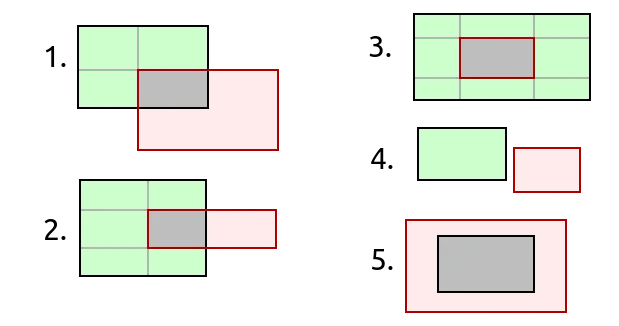为了完整的程序,Rectangle类被用作实际示例以展示其用法:
from itertools import combinations, product, starmap, tee
from pprint import pprint
from random import randint
TESTS = {
"0. Basics": [
{
"input":
[
[1, 1, 4, 5, 3.5],
[2, 6, 4, 8, 5],
[5, 1, 9, 3, 6],
[5, 5, 6, 6, 8],
[7, 4, 10, 6, 4],
[5, 7, 10, 8, 3]
],
"answer": 5,
"explanation": [5, 1, 3, 4, 0, 2]
},
{
"input":
[
[1, 1, 11, 2, 2],
[2, 3, 10, 4, 1],
[3, 5, 9, 6, 3],
[4, 7, 8, 8, 2]
],
"answer": 2
},
{
"input":
[
[1, 1, 3, 3, 6],
[5, 1, 7, 3, 6],
[9, 1, 11, 3, 6],
[1, 4, 3, 6, 6],
[5, 4, 7, 6, 6],
[9, 4, 11, 6, 6],
[1, 7, 11, 8, 3.25]
],
"answer": 4
},
{
"input":
[
[0, 0, 1, 1, 10]
],
"answer": 1
},
{
"input":
[
[2, 2, 3, 3, 4],
[2, 5, 3, 6, 4]
],
"answer": 1
},
],
"1. Extra": [
{
"input":
[
[1, 1, 3, 3, 20],
[3, 4, 5, 6, 10],
[5, 1, 7, 3, 20],
[1, 7, 7, 9, 20]
],
"answer": 4
},
{
"input":
[
[1, 1, 3, 3, 20],
[3, 4, 5, 6, 20],
[5, 1, 7, 3, 20],
[1, 7, 7, 9, 20]
],
"answer": 3
},
{
"input":
[
[0, 1, 1, 2, 2.5],
[0, 3, 1, 4, 3.5],
[0, 5, 1, 6, 1.5],
[3, 0, 4, 2, 30],
[5, 0, 6, 2, 2],
[7, 0, 8, 2, 2],
[4, 3, 8, 4, 2],
[4, 5, 5, 6, 1],
[7, 5, 8, 6, 3]
],
"answer": 7
},
{
"input":
[
[0, 0, 10, 1, 10],
[3, 3, 4, 4, 1],
[5, 5, 6, 6, 1],
[7, 7, 8, 8, 1]
],
"answer": 1
},
],
"2. Random": [
{
"input":
[
[0, 0, 10, 1, 10],
[3, 3, 4, 4, randint(1, 9)],
[5, 5, 6, 6, randint(1, 9)],
],
"answer": 1
},
{
"input":
[
[1, 1, 2, 2, 1],
[randint(3, 5), randint(3, 5), randint(6, 8), randint(6, 8), 1]
],
"answer": 2
},
]
}
def test():
for category, tests in sorted(TESTS.items()):
for test in tests:
i, a = test['input'], test['answer']
o = checkio(i)
if o != a:
print('Category:', category)
print(' Input:')
pprint(i, indent=8)
print(' Output:', o)
print(' Answer:', a)
def checkio(buildings):
buildings = sorted(starmap(Building, buildings), key=lambda b: b.z)
for a, b in combinations(buildings, 2):
if a.seen:
a.cover(b)
return sum(b.seen for b in buildings)
class Building:
def __init__(self, x1, y1, x2, y2, height):
self.rect = [Rectangle(x1, 0, x2, height)]
self.z = min(y1, y2)
def __str__(self):
return 'Z = {}; {}'.format(self.z, self.rect)
def cover(self, other):
for s in self.rect:
other.rect = list(flatten(o - s for o in other.rect))
@property
def seen(self):
return bool(self.rect)
def flatten(iterable):
if isinstance(iterable, Rectangle):
raise TypeError()
for item in iterable:
try:
yield from flatten(item)
except TypeError:
yield item
class Rectangle:
__slots__ = '__x1', '__y1', '__x2', '__y2'
def __init__(self, x1, y1, x2, y2):
self.__setstate__((min(x1, x2), min(y1, y2), max(x1, x2), max(y1, y2)))
def __repr__(self):
return '{}({})'.format(type(self).__name__, ', '.join(map(repr, self)))
def __eq__(self, other):
return self.data == other.data
def __ne__(self, other):
return self.data != other.data
def __hash__(self):
return hash(self.data)
def __len__(self):
return 4
def __getitem__(self, key):
return self.data[key]
def __iter__(self):
return iter(self.data)
def __and__(self, other):
x1, y1, x2, y2 = max(self.x1, other.x1), max(self.y1, other.y1), \
min(self.x2, other.x2), min(self.y2, other.y2)
if x1 < x2 and y1 < y2:
return type(self)(x1, y1, x2, y2)
def __sub__(self, other):
intersection = self & other
if intersection is None:
yield self
else:
x, y = {self.x1, self.x2}, {self.y1, self.y2}
if self.x1 < other.x1 < self.x2:
x.add(other.x1)
if self.y1 < other.y1 < self.y2:
y.add(other.y1)
if self.x1 < other.x2 < self.x2:
x.add(other.x2)
if self.y1 < other.y2 < self.y2:
y.add(other.y2)
for (x1, x2), (y1, y2) in product(pairwise(sorted(x)),
pairwise(sorted(y))):
instance = type(self)(x1, y1, x2, y2)
if instance != intersection:
yield instance
def __getstate__(self):
return self.x1, self.y1, self.x2, self.y2
def __setstate__(self, state):
self.__x1, self.__y1, self.__x2, self.__y2 = state
@property
def x1(self):
return self.__x1
@property
def y1(self):
return self.__y1
@property
def x2(self):
return self.__x2
@property
def y2(self):
return self.__y2
@property
def width(self):
return self.x2 - self.x1
@property
def height(self):
return self.y2 - self.y1
intersection = __and__
difference = __sub__
data = property(__getstate__)
def pairwise(iterable):
"s -> (s0, s1), (s1, s2), (s2, s3), ..."
a, b = tee(iterable)
next(b, None)
return zip(a, b)
if __name__ == '__main__':
test()
